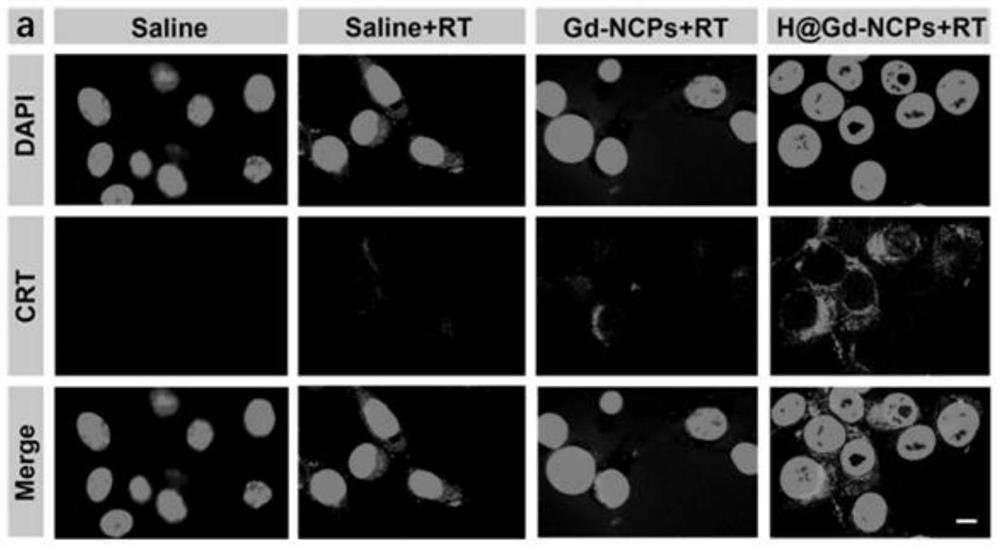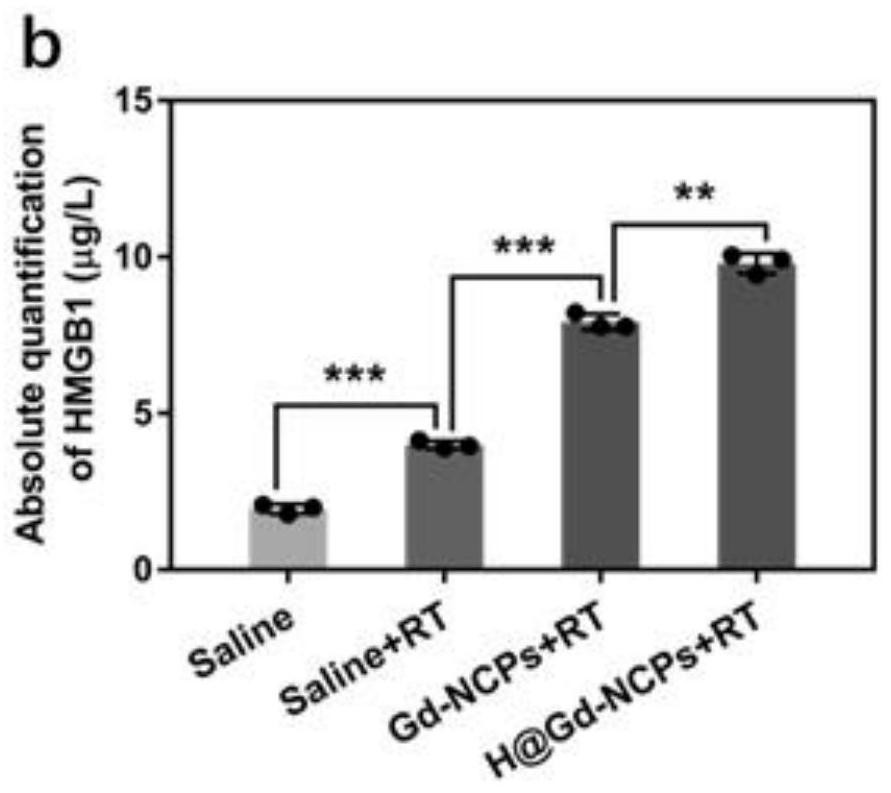Application of nanoscale coordination polymer Hemin (at) Gd-NCPs
A coordination polymer, nano-scale technology, applied in the field of biomedicine, can solve the problems of radiation therapy failure and weakening ability, and achieve the effect of activating the body's anti-tumor immune response, promoting release, and inhibiting liver and lung metastasis.
- Summary
- Abstract
- Description
- Claims
- Application Information
AI Technical Summary
Problems solved by technology
Method used
Image
Examples
Embodiment 1
[0034] Example 1 Hemin@Gd-NCPs-mediated radiation therapy induces strong eversion of CRT in tumor cells
[0035] First, CT26 cells were seeded on a 24-well plate at a density of 100,000 cells per well and cultured for 12 hours. Then, the Gd-NCPs ([Gd 3+ ]=100μM) and H@Gd-NCPs ([Gd 3+]=100 μM, [Hemin]=10 μM) were added to the cells respectively, and then transferred to an anaerobic chamber to continue treatment for 12 hours. After CT26 cells were irradiated (8Gy×1), they were cultured for 4 hours and washed 3 times with PBS. Tumor cells were incubated with Alexa Fluor 488-CRT antibody (dilution 1:500, Abcam, UK) for 1 hour and stained with DAPI. Immunofluorescence images were from Nikon Eclipse Ti (Japan) and analyzed using ImageJ software.
[0036] The result is as Figure 1a As shown, Hemin@Gd-NCPs-mediated radiotherapy treatment significantly induced CRT eversion in tumor cells, exhibiting the strongest green fluorescence signal.
Embodiment 2
[0037] Example 2 Hemin@Gd-NCPs mediated radiation therapy significantly induced tumor cells to secrete HMGB1 and ATP.
[0038] Detection of HMGB1 and ATP release. The concentration of HMGB1 in the cytoplasm and cell supernatant after each treatment was determined by using an ELISA kit (Ying Feixue Biotechnology, China) according to the instructions. ATP kit (Beyotime, China) was used to measure the concentration of ATP in the cell supernatant of each group according to the detection steps of the kit. Using a microplate reader ( Nivo) to detect fluorescence and absorbance.
[0039] The result is as Figure 1b , as shown in c. The concentration of HMGB1 and ATP in the Hemin@Gd-NCPs plus radiotherapy group measured by the kit was significantly higher than that in other groups.
Embodiment 3
[0040] Example 3 Hemin@Gd-NCPs-mediated radiation therapy significantly promoted the activation of DC cells in the draining lymph nodes of CT26 tumor-bearing mice.
[0041] In order to evaluate the maturation of DCs, CT26 tumor-bearing mice (110-130mm 3 ) were divided into 6 groups, which were given normal saline, [Gd 3+ ]=30mg / kg Gd-NCPs group, [Gd 3+ ]=30mg / kg and [Hemin]=12.5mg / kg H@Gd-NCPs group (6Gy×1) and normal saline, Gd-NCPs group, H@Gd-NCPs without radiotherapy group. Mice were sacrificed 5 days after radiation, and tumor-draining lymph nodes (TDLN) were collected for flow cytometry analysis. TDLNs were ground into a single cell suspension, mixed with FITC anti-mouse CD11c (0.25 μg per million 100 μL cell volume), PE anti-mouse CD86 (0.25 μg per million 100 μL cell volume), APC anti-mouse CD80 (1.0 μg 100 μL cell volume per million) were co-incubated with antibodies (BioLegend, USA), and then detected by flow cytometry.
[0042] The result is as figure 2 shown....
PUM
 Login to View More
Login to View More Abstract
Description
Claims
Application Information
 Login to View More
Login to View More - Generate Ideas
- Intellectual Property
- Life Sciences
- Materials
- Tech Scout
- Unparalleled Data Quality
- Higher Quality Content
- 60% Fewer Hallucinations
Browse by: Latest US Patents, China's latest patents, Technical Efficacy Thesaurus, Application Domain, Technology Topic, Popular Technical Reports.
© 2025 PatSnap. All rights reserved.Legal|Privacy policy|Modern Slavery Act Transparency Statement|Sitemap|About US| Contact US: help@patsnap.com



